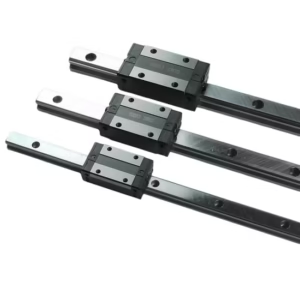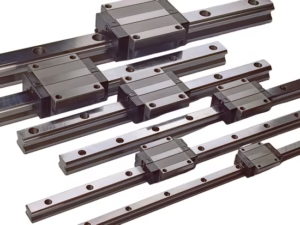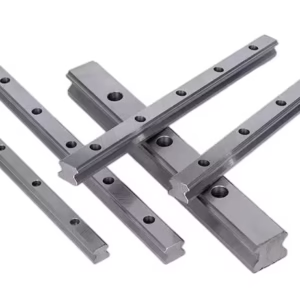Outline for Long-Form Article on Linear Rail Bearings
| Section | Sub-Headings |
|---|---|
| Introduction | Importance of linear motion systems, role of linear rail bearings |
| Linear Rail Bearings | What are linear rail bearings?, History and evolution of linear motion systems |
| Types of Linear Rail Bearings | Recirculating ball linear bearings, Roller-type linear bearings, Plain bearings, Hybrid bearings |
| Working Principle of Linear Rail Bearings | How linear bearings enable smooth motion, Load distribution and contact points |
| Advantages of Linear Rail Bearings | High precision, Reduced friction, Long lifespan, Energy efficiency |
| Common Applications of Linear Rail Bearings | CNC machines, 3D printers, Robotics, Automotive manufacturing, Medical equipment |
| Linear Rail Bearings in CNC Machines | Accuracy in cutting and milling, Durability under heavy loads |
| Linear Rail Bearings in 3D Printing | Smooth movement of print heads, Achieving high-resolution prints |
| Linear Rail Bearings in Robotics | Role in robotic arms, Automation and precision |
| Linear Rail Bearings in Medical Equipment | Surgical robots, Imaging devices |
| Key Materials Used in Linear Rail Bearings | Stainless steel, Aluminum, Ceramic coatings |
| Comparison: Linear Rail Bearings vs. Guide Rails | Differences in design, Efficiency, Cost considerations |
| Factors to Consider When Choosing Linear Rail Bearings | Load capacity, Speed requirements, Environmental conditions, Maintenance needs |
| Lubrication and Maintenance of Linear Rail Bearings | Importance of lubrication, Common lubricants, Maintenance schedules |
| Signs of Wear in Linear Rail Bearings | Noise, Vibration, Decreased accuracy |
| How to Extend the Lifespan of Linear Rail Bearings | Proper installation, Routine maintenance, Correct load distribution |
| Innovations in Linear Rail Bearings | Smart bearings, Advanced coatings, Lightweight materials |
| Challenges with Linear Rail Bearings | Cost, Installation complexity, Environmental limitations |
| Troubleshooting Linear Rail Bearings | Common issues and solutions, Misalignment problems |
| Cost of Linear Rail Bearings | Price ranges, Factors affecting cost |
| Top Manufacturers of Linear Rail Bearings | THK, Hiwin, NSK, Bosch Rexroth, SKF |
| Future of Linear Rail Bearings | Automation trends, Integration with AI and IoT |
| Environmental Impact of Linear Rail Bearings | Energy savings, Recycling materials, Eco-friendly lubrication |
| FAQs on Linear Rail Bearings | Practical, detailed answers |
| Conclusion | Final thoughts, long-term importance |
When it comes to precision, speed, and efficiency in mechanical systems, linear rail bearings are the unsung heroes. They form the backbone of industries ranging from automotive and aerospace to medical equipment and 3D printing. Without them, modern machines would suffer from inefficiency, excessive wear, and poor accuracy. These bearings ensure smooth motion, reduce friction, and extend the life of machines while keeping energy consumption low.
The beauty of linear rail bearings lies in their simplicity—they allow controlled, low-resistance sliding motion along a straight path. Yet behind this simplicity is advanced engineering that makes possible the remarkable accuracy and durability demanded in today’s automation-driven world.
Linear Rail Bearings
At their core, linear rail bearings are motion components that allow a load to move linearly, rather than rotationally. They consist of a guide rail and a bearing block, with rolling or sliding elements inside to minimize resistance. Unlike traditional sliding systems, which can wear quickly and generate friction, linear bearings are built for precision, smoothness, and longevity.
The idea of linear motion dates back to early mechanical devices where wooden slides were used. Over time, advancements in metallurgy and industrial demand led to the creation of recirculating ball bearings, followed by roller and hybrid designs. Today, linear rail bearings are found in everything from household 3D printers to massive industrial CNC machining centers.
Types of Linear Rail Bearings
Recirculating Ball Linear Bearings
These are the most common type, where tiny steel balls circulate inside the carriage. They roll along a groove in the rail, drastically reducing friction. Their self-recirculating system means the same balls can be used indefinitely, ensuring long-lasting smoothness.
Roller-Type Linear Bearings
Instead of spherical balls, these bearings use cylindrical rollers. The larger surface contact allows them to handle heavier loads without deformation. Roller bearings are typically found in industrial machinery where high stiffness and load capacity are crucial.
Plain Linear Bearings
These operate on the principle of sliding rather than rolling. Made from polymers, bronze, or composite materials, they are cost-effective, low maintenance, and work well in dirty or corrosive environments where ball bearings might fail.
Hybrid Linear Bearings
Hybrid designs combine elements of both rolling and sliding systems. For instance, a bearing may use rollers for heavy load-bearing areas and sliding contact in less critical sections. These are engineered for unique industrial needs where neither standard ball nor plain bearings are sufficient.
Working Principle of Linear Rail Bearings
The principle behind linear rail bearings is straightforward yet ingenious. The rail provides a track, while the bearing block holds rolling elements that reduce friction. As the block moves along the rail, the rolling elements recirculate internally, ensuring constant motion without binding or sticking.
Load is distributed across multiple contact points, which prevents localized wear. This ensures smoother performance under heavy-duty operations and extends the component’s lifespan. The result is seamless linear motion with minimal resistance, even under demanding conditions.
Advantages of Linear Rail Bearings
Linear rail bearings are popular because they offer several unmatched advantages:
High Precision: Essential for CNC machining and robotics.
Reduced Friction: Rolling contact significantly lowers energy losses.
Long Lifespan: Hardened rails and recirculating systems ensure durability.
Energy Efficiency: Motors consume less power due to reduced resistance.
Consistency: Movement remains accurate and repeatable over time.
These qualities make them indispensable for industries seeking reliability, efficiency, and precision.
Common Applications of Linear Rail Bearings
The use of linear rail bearings spans countless industries:
CNC Machines: For accurate positioning in cutting and milling.
3D Printers: For smooth head and bed movement, ensuring high-quality prints.
Robotics: For guiding robotic arms and manipulators with precision.
Medical Equipment: For surgical robots and diagnostic machines.
Automotive Production: In automated assembly lines for consistent performance.
Linear Rail Bearings in CNC Machines
CNC machines demand extreme precision and rigidity. Linear rail bearings provide the stability needed to ensure cutting tools move exactly as programmed. Their load-bearing capacity allows them to withstand the heavy stresses of milling, drilling, and grinding operations.
Without them, maintaining tight tolerances in metal cutting would be nearly impossible. Their role in CNC machining cannot be overstated—they are what make computer-controlled manufacturing accurate, repeatable, and efficient.
Linear Rail Bearings in 3D Printing
In 3D printing, even the slightest vibration or resistance can ruin a print. Linear rail bearings eliminate these issues by providing smooth, consistent movement for print heads and beds. Unlike cheaper bushings, they maintain accuracy over time, helping create sharper and cleaner layers.
This improvement in motion control has been one of the key reasons behind the surge in consumer and industrial-grade 3D printing quality.
Linear Rail Bearings in Robotics
Robotics is all about precision and repeatability. Robotic arms, automated pick-and-place machines, and collaborative robots all rely heavily on linear rail bearings. They provide the stability needed to ensure movements are exact, minimizing errors during automated tasks.
In industrial robotics, linear bearings also withstand repetitive stress, ensuring longevity in environments where machines work around the clock.
Linear Rail Bearings in Medical Equipment
Medical devices require gentle yet precise movements. Linear rail bearings are used in surgical robots, where accuracy is critical for patient safety, and in imaging systems, where smooth motion ensures accurate diagnostics. Their reliability makes them ideal for sensitive applications in healthcare.
Key Materials Used in Linear Rail Bearings
Linear rail bearings are manufactured using advanced materials:
Stainless Steel: High strength, corrosion-resistant, ideal for harsh environments.
Aluminum: Lightweight and cost-effective, suitable for smaller systems.
Ceramic Coatings: Enhance wear resistance and reduce friction further.
The choice of material depends on the application, environmental exposure, and required load capacity.
Comparison: Linear Rail Bearings vs. Guide Rails
While both guide rails and linear rail bearings assist linear movement, they are not the same.
Guide Rails: Simple sliding systems with less precision.
Linear Rail Bearings: Include rolling elements that minimize friction.
Linear rail bearings are superior when high accuracy, load capacity, and smoothness are needed, though guide rails remain useful in cost-sensitive, low-precision applications.
Factors to Consider When Choosing Linear Rail Bearings
When selecting the right bearing, engineers must evaluate:
Load Capacity: The expected weight and force during operation.
Speed Requirements: High-speed machines require low-friction designs.
Environment: Dust, moisture, and chemicals can affect performance.
Maintenance: Some designs require frequent lubrication, others are self-lubricating.
Choosing the wrong bearing can lead to premature wear, inefficiency, and costly downtime.
Lubrication and Maintenance of Linear Rail Bearings
Lubrication is critical for the performance and lifespan of linear rail bearings. Oils, greases, or advanced self-lubricating coatings are commonly used. A proper maintenance schedule includes:
Cleaning rails regularly.
Reapplying lubricants as recommended.
Checking for misalignment and wear.
Preventive maintenance ensures smooth operation and avoids costly replacements.
Signs of Wear in Linear Rail Bearings
Like any mechanical component, linear rail bearings eventually show signs of wear. Common indicators include:
Unusual Noise: Grinding or squeaking.
Vibration: Irregular movement under load.
Loss of Accuracy: Deviations in motion or positioning.
Addressing these issues early can extend bearing life significantly.
How to Extend the Lifespan of Linear Rail Bearings
Proper care can maximize lifespan:
Ensure correct installation and alignment.
Avoid overloading beyond rated capacity.
Apply lubrication regularly.
Use protective seals in dirty environments.
With the right precautions, linear rail bearings can last for years under continuous use.
Innovations in Linear Rail Bearings
Modern innovations are making bearings smarter and more durable:
Smart Bearings: Integrated sensors monitor wear and performance.
Advanced Coatings: Improve corrosion resistance and reduce friction.
Lightweight Materials: Use of composites and alloys to reduce system weight.
These advancements align with the increasing demand for high-performance automation.
Challenges with Linear Rail Bearings
Despite their many advantages, linear rail bearings face some challenges:
High Cost: Precision bearings are expensive.
Complex Installation: Requires alignment accuracy.
Environmental Limits: Extreme dirt, dust, or chemicals can reduce efficiency.
Mitigating these challenges requires proper planning and preventive maintenance.
Troubleshooting Linear Rail Bearings
When issues arise, common troubleshooting steps include:
Checking for misalignment of rails.
Ensuring lubrication is adequate.
Inspecting for contamination like dust or chips.
Replacing worn-out rolling elements if possible.
Quick troubleshooting prevents small issues from escalating into machine downtime.
Cost of Linear Rail Bearings
The cost varies widely depending on size, material, precision, and brand:
Entry-level bearings: $50–$200 for small-scale applications.
Mid-range bearings: $200–$800 for CNC and 3D printing.
Industrial-grade bearings: $1000+ for heavy-duty machinery.
Long-term cost savings come from durability and reduced energy consumption.
Top Manufacturers of Linear Rail Bearings
Some of the most trusted global manufacturers include:
THK (Japan): Known for innovation and durability.
Hiwin (Taiwan): Popular for affordability and reliability.
NSK (Japan): High-performance bearings for precision industries.
Bosch Rexroth (Germany): Premium-quality motion components.
SKF (Sweden): A leader in both rotary and linear bearings.
These brands set the standard for quality and innovation in the motion systems industry.
Future of Linear Rail Bearings
The future looks promising with increasing adoption of AI, IoT, and automation. Bearings with built-in sensors will enable predictive maintenance, reducing downtime and improving efficiency. Lighter, stronger materials will also push the boundaries of what machines can achieve.
As industries move toward sustainability, eco-friendly lubricants and recyclable materials will dominate manufacturing trends.
Environmental Impact of Linear Rail Bearings
Linear rail bearings contribute to sustainability by reducing energy loss through friction. Some manufacturers now use recyclable materials, while others develop eco-friendly lubrication systems. Efficient machines with high-quality bearings consume less power, making them a crucial part of greener manufacturing solutions.
FAQs on Linear Rail Bearings
What are linear rail bearings used for?
They are used to provide smooth, precise linear motion in machines like CNCs, 3D printers, and robotics.
How long do linear rail bearings last?
With proper maintenance, they can last several years, even under continuous use.
Do linear rail bearings need lubrication?
Yes, lubrication reduces friction and wear, significantly extending their lifespan.
Can linear rail bearings handle heavy loads?
Yes, especially roller-type bearings, which are designed for heavy-duty applications.
What is the difference between ball and roller linear bearings?
Ball bearings are more common and versatile, while roller bearings handle heavier loads with greater stiffness.
Are linear rail bearings expensive?
They can be costly, but the long-term efficiency and reduced downtime often outweigh the initial investment.
Conclusion
Linear rail bearings are the foundation of modern precision engineering. They make possible the accuracy and efficiency required in industries such as manufacturing, healthcare, robotics, and automation. By reducing friction, extending machine lifespan, and enabling high-precision motion, they play an irreplaceable role in advancing technology.
As innovations continue and smart materials emerge, the future of linear rail bearings will be marked by even greater performance, sustainability, and integration with smart technologies. Investing in the right linear rail system today is an investment in the reliability and productivity of tomorrow.
Suggested Inbound Links
CNC machining basics
Advantages of robotics in manufacturing
3D printing technology guide




